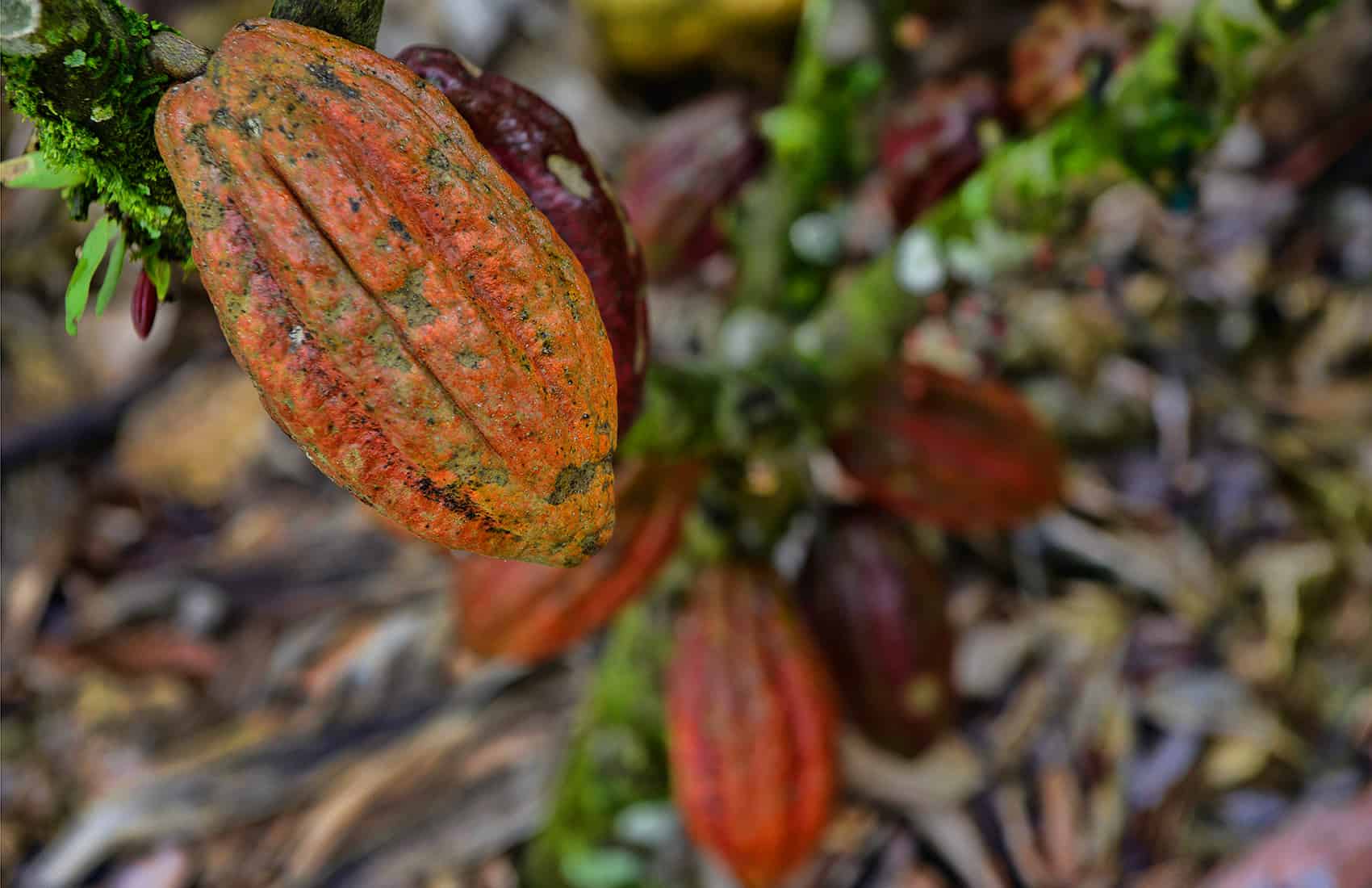Before the Europeans arrived in the Americas on the hunt for gold, the region’s indigenous people used money that literally grew on trees. The tiny brown seeds that came to be known as cacao beans held real value, and the Incas, the Aztecs and Costa Rica’s Chorotega people all used cacao as currency. For them, it was worth as much as gold.
Today, with a chocolate shortage on the horizon, the value of Latin America’s cacao crop might rise again. Political conflicts, poor work conditions and plant diseases are beginning to take a toll on the bulk of chocolate growers on Africa’s western coast, but interest in the product continues to climb.
To fill the growing demand, luxury chocolatiers and large corporations are looking to other parts of the world. The new shift has the potential not only to change the way we consume chocolate, but also to alter the face of sustainable agriculture in Central America.
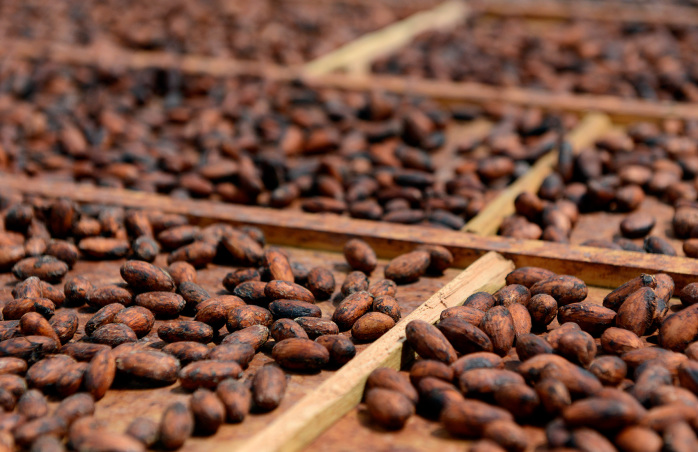
See the whole bean-to-bar process in our gallery.
Fifty years ago, the Salazar family farm was one of many on Costa Rica’s central Pacific coast, where at least 20 cacao plantations dominated the landscape. Now most of that land is clear-cut cattle pasture.
When the monilia fungus showed up in the 1970s, the Salazars decided to maintain their generations-old cacao crop, but with the added cost of aggressively monitoring trees. No one else followed suit.
The fungus devastated 80 percent of Costa Rica’s cacao crop, forcing nearly all of the country’s small growers to abandon or change their farms. While Pacific plantations began to favor ranching, the country’s Caribbean, once covered in cacao plantations, was replanted with bananas.
Crop diseases spread throughout Latin America, and while Central America struggled to manage fungus, South America lost crops to another disease called witch’s broom. Even the great producers in cacao’s cradle, Brazil and Ecuador, couldn’t keep up production. Chocolate companies turned to their already-thriving African plantations to make up the difference.
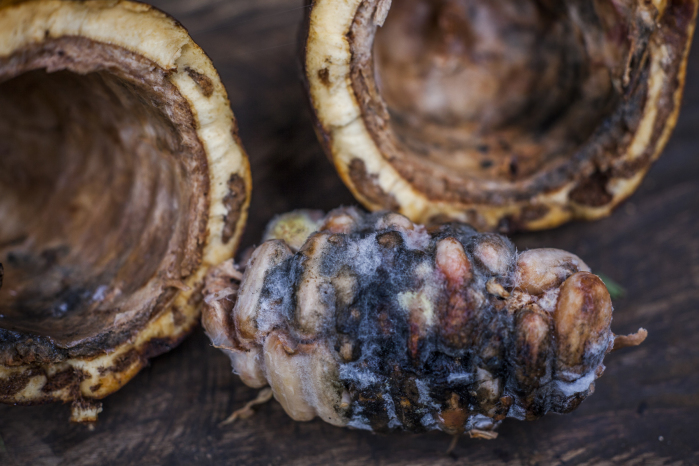
Though not a native home to cacao, Africa was the perfect solution for chocolate-loving 19th century Europeans. To spare the hefty transportation costs of importing cacao from the Americas, countries like England and France planted it in their African colonies. The crop thrived in the continent’s tropical climates.
Bulk production soon became the focus for Africa’s cacao plantations, and most farmers planted the low quality but highly productive forastero variety. Africa now produces more than 70 percent of the world’s cacao, half of which comes from the conflict-ridden Ivory Coast. Today, the region grows nearly every cacao bean in a typical supermarket chocolate bar, but market experts believe Africa may not be able to keep up with demand.
Low wages and increasing fertilizer costs give younger farmers little incentive to grow cacao. Aging trees and diseases like the bean-withering black pod and tree-killing swollen shoot are another problem. It takes five years before a cacao tree will bear fruit, and replacing old cacao trees usually involves developing a new piece of land.
Paired with West Africa’s political instability, these burgeoning agricultural pitfalls could make chocolate a luxury item. With demand skyrocketing, the industry is already starting to feel the squeeze.
“Chocolate demand goes up about 25 percent every 10 years,” said Raymond Major, the senior manager of sustainable initiatives for the Hershey Company. “What is really interesting now is what is happening in Asia. If demand continues to grow there, it will really affect what happens in the future with chocolate demand.”
According to The International Cocoa Organization’s projections, there will be a 70,000-ton cacao shortage in 2014. But chocolate fans shouldn’t expect their favorite candy bars to disappear just yet.
*
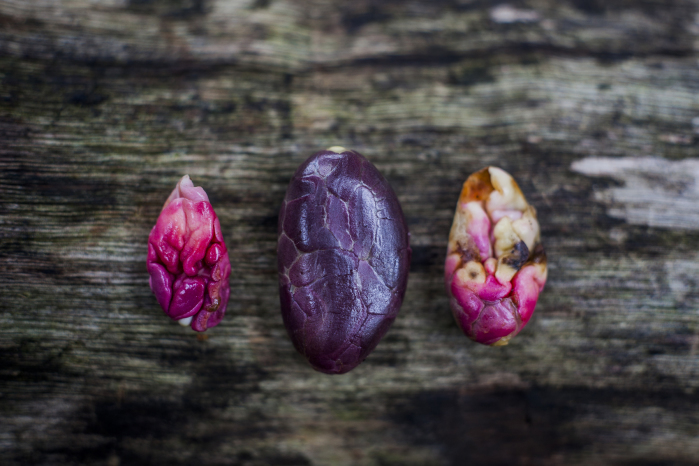
When people hear the word clone, they usually think of a mad scientist in a white lab coat or a creepy Star Wars-like army of identical soldiers. Less often do they imagine Wilberth Phillip’s modest cacao genetic improvement laboratory at the Tropical Agricultural Research and Higher Education Center (CATIE).
Located in central Costa Rica’s Turrialba, CATIE doesn’t have any sterile high-tech laboratories; instead the grounds are filled with what look like rows of greenhouses.
Stocked with Petri dishes full of cacao-killing fungus, the microscopes and small experiment stations look like a high-school chemistry classroom. But this lab also happens to hold the strains of cacao that may save the chocolate industry.
“What we are doing here gives farmers in this region the chance to grow cacao again,” Phillips said. “It took a while, but we are beating the cacao diseases.”
Founded as an educational and research center in the 1940s, CATIE houses the world’s most important research on the biology of the tropics. The center has worked on cacao genetic improvement since the beginning, but the program really picked up 40 years ago when diseases first began wreaking havoc in Latin America.
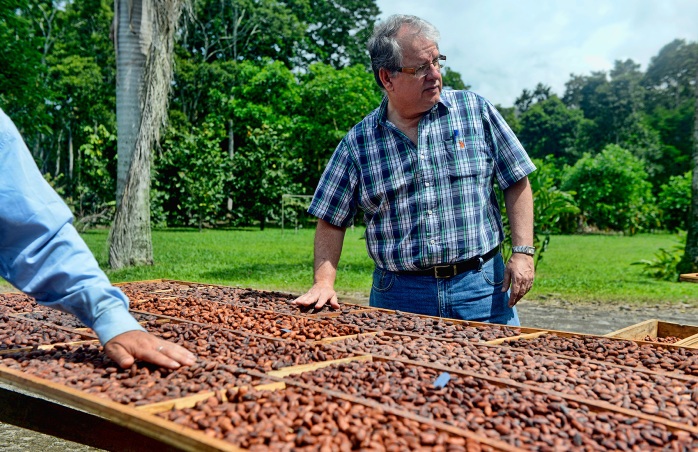
Researchers started by identifying strains of cacao resistant to monilia and other diseases. In the second stage, which Phillips refers to as “the arranged marriages stage,” CATIE crossbred selected strains for optimal disease resistance.
With disease-proof cacao in hand, CATIE began breeding other desirable traits into clones, like high yield rates and fine flavor.
“Your daughter is beautiful, and she can also sing – that’s what we want people to say about our cacao,” Phillips said. “Our clones won’t die on you, and they also produce great-tasting chocolate.”
The first round of high-quality cloning took 26 years. After each stage of breeding, researchers had to plant the cacao, wait five years to harvest the beans and then evaluate. The results include six final clones.
For all of their similarities in disease resistance, the clones could not look more different. The cacao pods come in fat ovals and thin cylinders; their outer skin ranges from dark purple to pale green. Their textures go from perfectly smooth to bumpy and ridged. The clones vary also in their ability to ward off monilia, and in traits such as high-productivity and short stature for high-density farms.
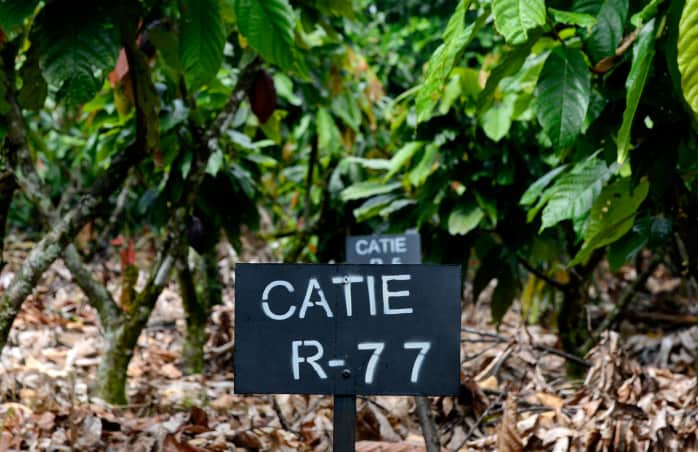
Sheltered under a canopy of banana trees and hardwoods and marked with numbered placards, the clones’ genetic material is stored in rows of planted trees at the center’s international cacao collection. The CATIE clones are mixed with others from Brazil, Ecuador and African countries.
There is no other cacao collection in the world like CATIE’s in Latin America, and for small farms, the clones are available for free.
CATIE has smaller clone gardens distributed throughout the region. Farmers can visit these gardens and pick up the clones’ seeds. The first of these was planted about six years ago, and some are starting to bear fruit. The obstacle now is to get more farmers to grow it.
Cacao still has a long way to go to become the cash crop that it once was. Before the monilia virus, there were more than 10,000 hectares of cacao planted in Costa Rica. Today, despite clones and other disease fighting measures, cacao plantations cover slightly more than 4,500 hectares.
But the number is climbing.
“It has been a challenge to get farmers to trust these clones,” Phillips said. “There aren’t as many out there as we want, but if Costa Rican farmers start using these, they won’t regret it.”
*
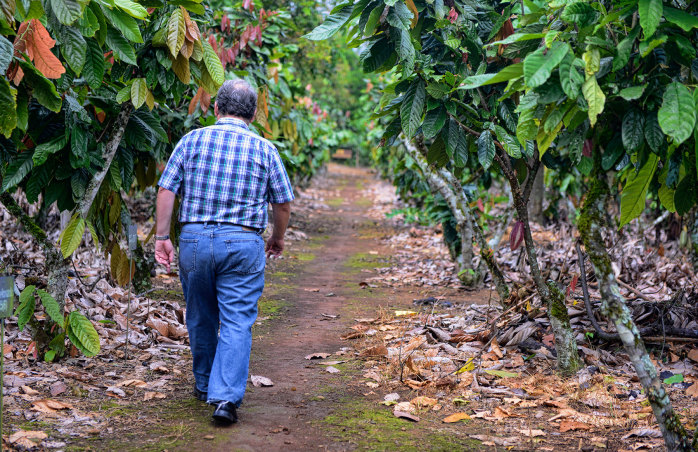
The Salazars survived the fungus by revamping their farm, which meant making and selling chocolate along with growing cacao. Now, with Central American cacao again on the rise, that business model is being mimicked across the country.
Just a short drive north from San José to the mountains of San Isidro de Heredia, Julio Fernández and George Soriano have established a mini chocolate factory, Sibú Chocolate, which has become a popular destination for tourists and locals.
After a mug of strong cocoa and a tasting of an assortment of truffles, visitors watch chocolatiers pour vats of thick dark liquid into molds. They scrape off the excess and let their guests lick the spoon. Watching the process is enough to make any chocolate connoisseur salivate, and Sibú guides pair through the tasting with fascinating explanations of how chocolate was and is made.
The concept is bean-to-gourmet-bar, and it has quite a few benefits. With higher-quality, handmade cacao, Soriano says he can ask a higher price and fairly pay farmers. A kilo of cacao beans in Africa will fetch farmers little more than $1, but in Costa Rica, export cacao sells for more than $2 a kilo. Some Costa Rican cacao can sell for $4 a kilo.
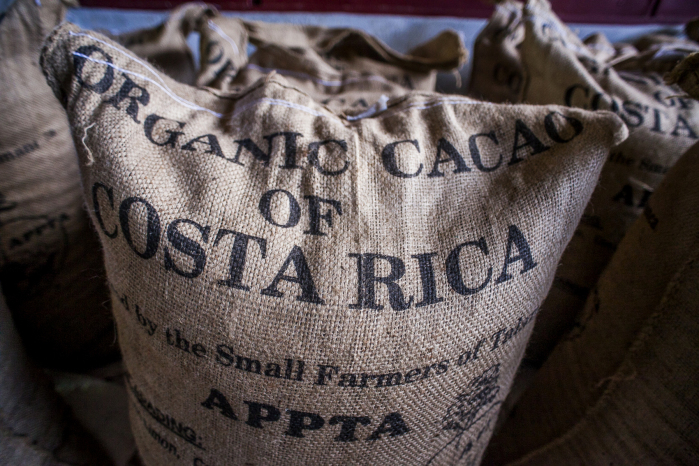
“There is the bulk cacao market that exports for most of the world’s chocolates, then there is what we are,” said Paul Johnson, owner of Caribeans, a bean-to-bar operation located in the country’s Southern Caribbean. “We are looking for the Napa Valley effect. We want to create a fine chocolate to properly pay cacao workers.”
As in the rest of the world, fine chocolates only make up a small part of the market in Costa Rica. Currently, the small country does not produce enough to become a major player in the world of cacao.
“The economic model needs to be developed more,” Major said. “[Central American] countries produce great cacao, but they don’t produce enough for the bulk chocolate makers, and they produce too much for the fine-flavor business.”
To better meet bulk demand, a large chunk of Costa Rica’s cacao growers join cooperatives. The country’s largest is the Association of Small Producers of Talamanca (APPTA), on the Caribbean coast.
Using CATIE’s clones, APPTA has tripled its production in the last three years, and the cooperative expects that number will continue to increase as more farmers are drawn to cacao.
“Cacao farms are far less expensive and less work than other cultivations,” said Jairo Garipa, the chief of exportations with APPTA. “Once people start to hear about the advantages, they’ll want in too.”
*
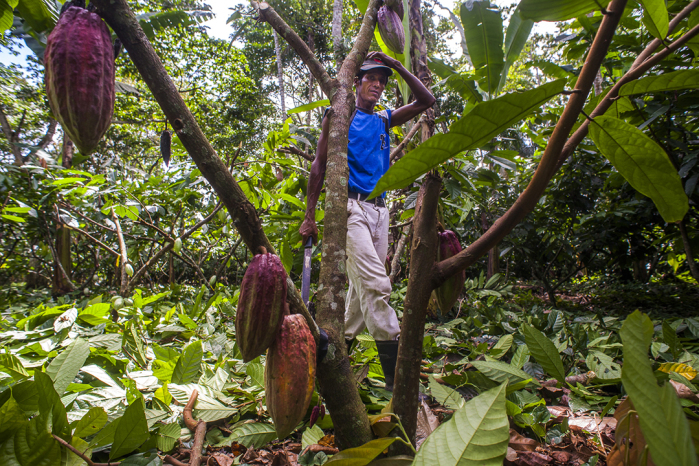
In 2007, research revealed that dark chocolate was in many ways good for the body. Ever since, fine chocolate has been one of the fastest growing segments of the chocolate market.
This is especially good news for Costa Rica, the only country in Central America (and one of nine in the world) that exports 100 percent fine flavor cacao, according the International Cocoa Organization. In 2013, samples of Costa Rican cacao were also named among the 50 best in the world.
“What Costa Rica did with high-quality coffee in the past, we really have everything that we need to do the same with cacao,” Soriano said. “We can be a country known for our fine-flavor cacao beans in the same way that we are known for our fine-flavor coffee beans.”
Although Costa Rica’s cacao quality surpasses that of other countries in the region, its production does not. Honduras and Nicaragua both have well-developed government programs for cacao growers, while Costa Rica’s production remains in its infancy.
“The cacao boom is happening all over the region,” Phillips said, “but the boom in other countries has been bigger. Costa Rica needs to begin taking advantage of what it has.”
Costa Rica’s Agriculture and Livestock Ministry (MAG) is starting to agree. Lloyd Foster-Russell, the head of MAG’s National Cacao Program, said cacao could revitalize Costa Rica’s agricultural landscape.
“Cacao has characteristics that could be extremely valuable for the country,” Foster-Russell said. “It is among the best farms for the environment and for a farmer’s long-term investment.”
Unlike bananas and pineapple, Costa Rica’s biggest agricultural exports, cacao requires very few agrochemicals. Cacao trees also require shade to thrive, meaning they can be planted in forests without clear-cutting. MAG is also exploring the idea of using cacao plantations to replace low-altitude coffee plantations rendered useless by rising temperatures.
Cacao’s ability to grow in the forest benefits farmers as well, enabling them to grow multiple crops in the same area. Hardwoods, bananas and other plants can all occupy the same plantation as cacao. When farmers are not harvesting their cacao beans, they can still make money from other crops.
“This type of model hasn’t really caught on in Africa, but is ideal for Central America,” Major said. “[It] can give farmers income every day. It benefits farmers and the environment.”

